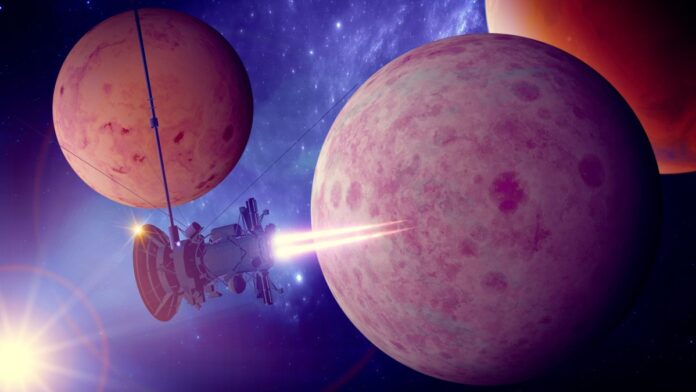Astronomers are finding new exoplanets almost every day, but due to the incredible distances between star systems, space exploration has been limited to our solar system. For example, it is estimated that the Voyager 1 spacecraft, presently traveling away from the sun at 10.7 miles per second (17.3 kilometers per second), would take over 73,000 years to reach Proxima b, the nearest confirmed exoplanet.
But what if traveling to exoplanets were no longer the purview of science fiction? What if we could actually do it?
To solve this physics-defying conundrum, scientists would have to turn to propulsion systems that are far more advanced than the chemical rockets we currently employ for our exploration needs. One such proposed technology is antimatter-based propulsion, which, as its name implies, involves using antimatter to power a spacecraft to velocities reaching a few percent of the speed of light.
Related: Is interstellar travel really possible?
Antimatter isn’t new for physics; its existence was first confirmed in 1932 by Carl Anderson, who discovered positrons, electrons that exhibit a positive charge instead of a negative one. But how important is it to establish antimatter-based propulsion systems to explore beyond our solar system?
“Setting priorities is always a matter of weighing costs and benefits,” Gerald Jackson, co-founder and president of Hbar Technologies Inc. and the author of a new paper investigating the idea of using antimatter-based propulsion for exoplanet exploration, told Space.com in an email. “Is antimatter-based propulsion for interstellar travel more important than childhood glioma in the next year? Of course not. In my opinion, there should at least be some small amount of support for long-term technologies that are not needed in the current or next fiscal year. There are many examples of technologies that enjoy low level support, only for society to find that they desperately need it.
“There are many scenarios where humanity may find that it needs to quickly send spacecraft into interstellar space,” he said. “In my opinion antimatter-based propulsion is the best solution for such a need.”
Jackson’s study focuses primarily on the physics responsible for the propulsion system to work, with an emphasis on nuclear fission; the paper describes an electrostatic nozzle and trap meant to carry out the necessary fission. So when could we expect this antimatter-based propulsion technology to actually be developed? This is a common question but also a common trap, Jackson said.
“Robert Goddard developed liquid fuel rockets, staging, and gyroscopic guidance systems long before they were needed for manned [sic] exploration of low Earth orbit and the moon,” he told Space.com in an email. “If it had not been for World War II and the subsequent Cold War, you could argue that mankind would still have not landed on the moon. In human history, need plays a dominant role in technology development speed. I do not have a good enough crystal ball to give a good answer. Of course, funding levels go hand-in-hand with need.”
Jackson referenced attempts to develop the necessary technology to travel to Proxima b. One such attempt was the May 2016 decree by then-U.S. Rep. John Culberson that NASA travel to the Alpha Centauri system by 2069, the 100th anniversary of the Apollo 11 moon landing. But Jackson noted that there is “insufficient time for any prospective technology to be developed sufficiently to meet that optimistic date.” He also cited Breakthrough Starshot as another ongoing attempt to send a mission to Proxima b but noted that there’s still a long way to go.
“At this moment there is almost no research money dedicated to advanced, deep-space propulsion research,” he told Space.com in an email. “Sporadically there are miniature bursts of activity, such as current work resurrecting nuclear propulsion for manned Mars missions and privately funded Starshot. Even the NASA NIAC [Innovative Advanced Concepts] program is spread too thin to provide consistent funding. What is needed is a long-term, steady level of funding that allows a dozen researchers or so to work for decades on a broad array of innovative propulsion concepts.”
The antimatter propulsion proposal is described in a paper published in the journal Nuclear Technology.
Follow us on Twitter @Spacedotcom and on Facebook.

